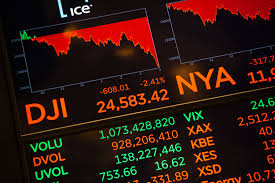Wall Street Says the Stock Market Will Soar This Year. Don’t Fall For the Fantasy

On Monday, the Wall Street Journal reported that America’s major banks and brokerages were reducing their 2019 year-end targets for the S&P 500. But they didn’t reduce them by very much. Indeed, the eight institutions that the Journal cited (subscription required) in an accompanying chart are remarkably aligned in predicting that 2019 will deliver splendid gains.
On average, the stalwarts—including J.P. Morgan Chase, Goldman Sachs, and Wells Fargo—forecast that the benchmark S&P index will finish this year at around 2907, rising 16% from its December 31 close of 2507. (Optimism runs highest at JPMorgan Chase, Goldman, BTIG and BMO Capital Markets, which all predict that the S&P will rise at least 20%.)
Add the index’s current 2% dividend yield to the 16% average, and by Wall Street’s reckoning, America’s big-cap stocks will enrich investors by 18% for 2019. That’s not just a good year: That would be the fifth best year of this century, and far better than the historic average of just under 10%.
But despite a roaring start to the year that has lifted the S&P by 3% in the first six days of trading, investors should be extremely skeptical of Wall Street’s enthusiasm. Pundits and market strategists are inviting you to fantasyland. Don’t go there.
Falling profits threaten stocks
For months, the banks’ forecasts for 2019 profits have been falling from double-digit increases to gains of 6% to 8%. So to achieve that midpoint forecast of 16%, the S&P’s multiple would need to rise from the current 18.2 (based on 12-month trailing GAAP earnings) to around 20.
It’s unlikely to happen. Profits are already in a near-bubble, based on all traditional metrics including return on equity and sales, and share of national income. In fact, Yale economist Robert Shiller’s CAPE, or cyclically adjusted price-to-earnings ratio, a measure that smooths earnings to remove one-time peaks and troughs, now stands at a super-rich 29, a level only exceeded during the ill-fated frenzies of 1920 and 2000.
Hence, the best assumption is that the market multiple remains at its current level of 18.2, which is about average for the past two decades, though far above the level of around 16 for the past century. In that scenario, GAAP earnings-per-share would need to wax at the same pace as the prediction for the S&P index, by 16%, to meet the banks’ average targets. Three drivers will determine whether that happens.
The first is the level of buybacks that lower the total shares outstanding, and as a result, lift EPS. The second is the basic performance of the underlying business—in other words, how much it improves each year without adding new growth capital. And the third, and most crucial, is the returns achieved on each dollar of growth capital. That growth capital consists of the retained earnings, profits reinvested in expanding the business, in building new plants and retooling existing one for new products, opening stores, or constructing “fabs” to manufacture groundbreaking software.
Let’s examine what each factor is likely to contribute, and whether together they can possibly reach the big banks 16% target.
A formula for more
We’ll start with buybacks, which lowers shares outstanding and thus goose earnings per share. In a recent story (“Stock Prices Have Plummeted, That Doesn’t Make Them Good Buys“) I understated the importance of share repurchases, and as we’ll see, possibly the underlying businesses’ potential, in achieving outsized profit increases.
In a report this week, “Stock Market Indicators: S&P 500 Buybacks and Dividends,” Yardeni Research, headed by economist Edward Yardeni, noted that total buybacks in 2018 reached around $ 800 billion. According to Howard Silverblatt, senior industry analyst at S&P, that’s an all-time high, beating the previous record posted in 2007 by 36%. As Yardeni Research points out, around $ 150 billion of that $ 800 billion went toward retiring stock options and other equity instruments issued for compensation or as part of convertible bond issues. The balance of $ 650 billion funded purchases on the open market that actually lowered the number of shares outstanding, and as a result, raised earnings per share.
It’s likely that buybacks will continue at historically high rates. The companies in the Fortune 500 have announced “authorizations” to repurchase over $ 1 trillion in shares in the coming two years or so, and more repurchase announcements are expected. So it’s possible that net repurchases for 2019 could equal or exceed last year’s record.
At first glance, that $ 650 billion number looks like a mathematical impossibility. By S&P’s reckoning, the S&P 500 posted roughly $ 1.2 trillion in GAAP profits for 2018, a record performance. Those 500 companies pay out about 39% of total earnings, or $ 470 billion a year, in dividends. So dividends and repurchases would appear to absorb almost all of GAAP earnings.
That’s not the case, for a basic reason. By Fortune‘s estimates, around $ 300 billon of the net buybacks (and $ 450 billion in total buybacks) are being financed either by fresh borrowings, or from cash on the balance sheets, much of it repatriated from foreign subsidiaries at the favorable tax rates established under corporate tax reform that took effect at the start of 2018. The S&P 500 are paying the remainder, of $ 350 billion, from earnings. Since the S&P’s market cap is now around $ 22.4 trillion, another $ 650 billion in buybacks in 2019 would lower the share count by 2.9%.
Hence, repurchases could realistically provide that portion of the required 16% rise in earnings-per-share. That leaves 13.1%, or an extra $ 155 billion, that would need to come from the two other drivers, the performance of the standalone business (excluding new investment), and the lift from retained earnings plowed into growing the business.
Improvements wanted
How much can we expect the 500 companies to lift earnings by raising prices, achieving new efficiencies, or outsourcing IT––in other words, by doing what they do now a lot better, without adding new capital?
Some companies, including those with great brands, succeed in raising prices faster than inflation. But for most of the 500, prices increases are constrained by competition, and track the CPI–indeed, they are the CPI. As for productivity, companies are constantly finding new ways to lower the costs of producing each car, mobile phone or gigawatt of electricity by using less labor and squeeze the volumes from using fewer plants and machines.
The rub is that when one company leapfrogs the others in lowering unit costs, its rivals find ways to catch up, so that costs, and prices, fall across the entire industry. Overall, unit sales tend to grow with the economy. For 2019, the Congressional Budget Office predicts that GDP will expand at 2.4%, or 4.4% including inflation. Traditionally, EPS has increased at about one point less, because new competitors, whether startups or invaders from China, are constantly entering existing industries, stealing market share from incumbents.
Still, we’ll nod to Wall Street and adopt the “best case” that for America’s big caps, the underlying businesses will raise EPS by 4.4% in 2019, tracking the predicted growth in the overall economy. The first two drivers, the 2.9% boost from buybacks and the 4.4% lift from the “standalone” business, combine to generate 7.3% of the required 16% growth in EPS.
That scenario leaves the heavy lifting to the third factor, retained earnings. The profits that the S&P reinvests for expansion would need to generate more than half the 16% target. Specifically, the extra earnings from fresh investments in new plants, stores and fabs created by those “growth earnings” have to add 8.7% to last year’s total profits (the 16% target minus 7.3% for buybacks and standalone gains). Hence, the bogey for gains on retained earnings is just over $ 100 billion.
By the way, the actual number that the S&P 500 retains and reinvests each year is by no means easy to find. This writer has read sundry reports from Wall Street market strategists and economists, and has never seen the retained earnings number spotlighted, nor any projected return on those reinvested profits. Wall Street doesn’t seem particularly interested in how much companies reinvest, or how much those companies need to earn on each dollar of those reinvested profits to hit their usually elevated profit goals. I was able to make the $ 350 billion estimate by using annual increases in book value of around 5% a year, and multiplying by total S&P 500 book value of $ 7 trillion. By my calculations, the S&P 500 is spending 25% of its profits on net buybacks, 39% on dividends, and reinvesting 36% in retained earnings.
That 36% represents an investment for 2019 of around $ 450 billion, including extra profits generated during the year. Keep in mind that to hit the 16% target, the 500 would need to generate the additional $ 100 billion on that investment. That’s a 22% after-tax, or 28% pre-tax, return.
So assume that the big caps generate a return on reinvested profits that’s more reasonable, say 6%. That would add 2% to returns, for a total of 9.3%. Achieving even that number would be a giant stretch. Our assumption is that the standalone scenario tracks GDP. That would be probable if profits were starting at normal levels, but they’re so highly inflated that even matching inflation will prove a challenge. Labor costs and interest rates are rising, and the one-time boost from the corporate tax cut won’t repeat. Despite those headwinds, Wall Street’s bluebird predictions in effect incorporate giant gains on reinvested profits. Yet the slender reed on which their forecasts depend is seldom discussed, for good reason it would appear.
Do you really believe that the 500 would be paying out 64% of their earnings in low-yielding dividends and buybacks if they could make 22% on dollars they retain? Let the pros answer that question. Case closed.










